Battle of Mobile Bay. Washington, DC: Naval Historical Foundation, 1964.

The Navy Department Library
Battle of Mobile Bay
5 August 1864
Official reports of Rear Admiral David G. Farragut
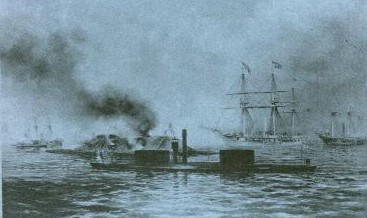
"Battle of Mobile Bay"
The official reports of Admiral David G. Farragut on 5 and 12 August 1864, with the general orders published prior to and after the battle.
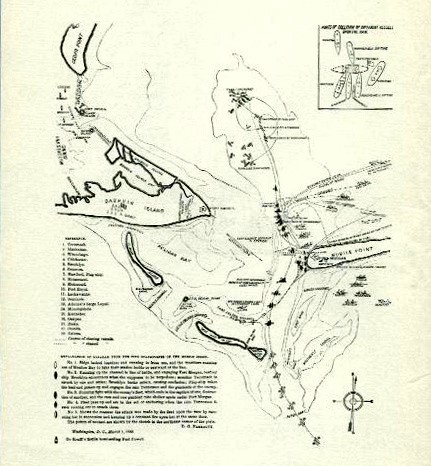
General order of Rear-Admiral Farragut, U. S. Navy.
GENERAL ORDERS, NO. 10. |
|
|
U.S. FLAGSHIP Hartford, |
Strip your vessels and prepare for the conflict. Send down all your superfluous spars and rigging. Trice [haul] up or remove the whiskers [spars projecting just forward of the cathead, used to make sails wider]. Put up the splinter nets [nets used to protect seamen from falling wood splinters when masts or spars hit by gunfire] on the starboard side, and barricade the wheel and steersmen with sails and hammocks. Lay chains or sand bags on the deck over the machinery, to resist a plunging fire. Hang the sheet chains over the side, or make any other arrangement for security that your ingenuity may suggest. Land your starboard boats or lower and tow them on the port side, and lower the port boats down to the water's edge. Place a leadsman [sailor with string and lead plumb who would measure depth of water] and the pilot in the port quarter boat, or the one most convenient to the commander.
The vessels will run past the forts in couples, lashed side by side, as hereinafter designated. The flagship will lead and steer from Sand Island N. by E. by compass, until abreast of Fort Morgan; then N. W. half N. until past the Middle Ground; then N. by W., and the others. as designated in the drawing, will follow in due order until ordered to anchor; but the bow and quarter line [area of ship from main mast to back of ship] must be preserved to give the chase guns a fair range, and each vessel must be kept astern [behind] of the broadside of the next ahead; each vessel will keep a very little on the starboard quarter of his next ahead, and when abreast of the fort, will keep directly astern, and as we pass the fort will take the same distance on the port quarter of the next ahead, to enable the stern guns to fire clear of the next vessel astern.
It will be the object of the admiral to get as close to the fort as possible before opening fire. The ships, however, will open fire the moment the enemy opens upon us, with their chase and other guns, as fast as they can be brought to bear. Use short fuzes for the shell and shrapnel, and as soon as within 300 or 400 yards give them grape [grapeshot-cannon balls with a diameter measuring less than one half the caliber of the cannon from which it is fired]. It is understood that heretofore we have fired too high, but with grapeshot it is necessary to elevate a little above the object, as grape will dribble from the muzzle of the gun.
If one or more of the vessels be disabled, their partners must carry them through, if possible; but if they can not then the next astern must render the required assistance; but as the admiral contemplates moving with the flood tide, it will only require sufficient power to keep the crippled vessels in the channel.
Vessels that can must place guns upon the poop [highest deck at the rear of the ship] and topgallant forecastle [small high deck on top of forecastle] and in the tops on the starboard side. Should the enemy fire grape, they will remove the men from the topgallant forecastle and poop to the guns below until out of grape range.
The howitzers must keep up a constant fire from the time they can reach with shrapnel until out of its range.
D.G. Farragut,
Rear-Admiral, Commanding West Gulf Blockading Squadron.
__________________________
General order of Rear-Admiral Farragut, U. S. Navy.
GENERAL ORDERS, NO. 11. |
|
|
U.S. FLAGSHIP Hartford, |
Should any vessel be disabled to such a degree that her consort is unable to keep her in her station, she will drop out of line to the westward and not embarrass the vessels next astern by attempting to regain her station. Should she repair damages, so as to be able to reenter the line of battle, she will take her station in the rear as close to the last vessel as possible.
So soon as the vessels have passed the fort and kept away N. W., they can cast off the gunboats at the discretion of the senior officer of the two vessels, and allow them to proceed up the bay to cut off the enemy's gunboats that may be attempting to escape up to Mobile. There are certain black buoys placed by the enemy from the piles on the west side of the channel across it toward Fort Morgan. It being understood that there are torpedoes and other obstructions between the buoys, the vessels will take care to pass to the eastward of the easternmost buoy, which is clear of all obstructions.
So soon as the vessels arrive opposite the end of the piles, it will be best to stop the propeller of the ship and let her drift the distance past by her headway [forward momentum of the ship in water] and the tide, and those having side-wheel gunboats will continue on by the aid of their paddle wheels, which are not likely to foul with the enemy's drag ropes.
D. G. Farragut,
Rear-Admiral.
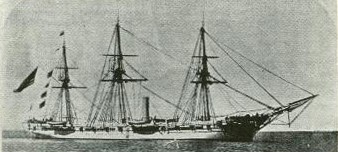
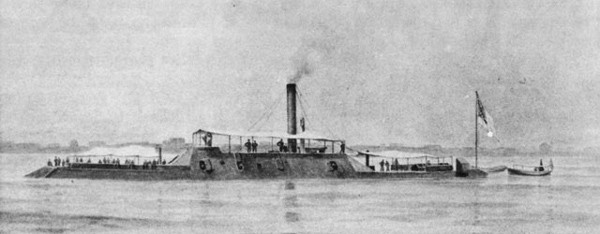
Report of Rear-Admiral Farragut, U.S. Navy, regarding the battle of Mobile Type Bay, August 5, 1864
No. 335.] |
|
|
FLAGSHIP Hartford, |
Sir: I have the honor to report to the Department that this morning I entered Mobile Bay, passing between Forts Morgan and Gaines, and encountering the rebel ram Tennessee and the gunboats of the enemy, viz, Selma, Morgan, and Gaines.
The attacking fleet was underway by 5:45 a.m., in the following order:
Brooklyn with the Octorara on her port side, Hartford with the Metacomet, Richmond with the Port Royal, Lackawanna with the Seminole, Monongahela with the Kennebec, Ossipee with the Itasca, and Oneida with the Galena.
On the starboard of the fleet was proper position of the monitors of ironclads.
The wind was light from the southward and westward; the sky cloudy with very little sun.
Fort Morgan opened upon us at six minutes past 7, and soon after this the action became lively. As we steamed up the Main Ship Channel there was some difficulty ahead and the Hartford passed on ahead of the Brooklyn. At forty minutes past 7 the monitor Tecumseh was struck by a torpedo and sank, going down very rapidly and carrying with her all of her officers and crew with the exception of the pilot and 8 or 10 men, who were saved by a boat that I sent from the Metacomet alongside of me.
The Hartford had passed the forts before 8 o'clock, and finding myself raked by the rebel gunboats I ordered the Metacomet to cast off and go in pursuit of them, one of which, the Selma, she succeeded in capturing.
All the vessels had passed the forts by 8: 30 o'clock, but the rebel ram Tennessee was still apparently uninjured in our rear.
Signal was at once made to all the fleet to turn again and attack the ram, not only with the guns, but with orders to run her down at full speed. The Monongahela was the first that struck her, and, though she may have injured her badly, yet did not succeed in disabling her. The Lackawanna also struck her, but ineffectually, and the flagship gave her a severe shock with her bow, and as she passed poured her whole port broadside into her, solid IX-inch shot and 13 pounds of powder, at a distance of not more than 12 feet. The ironclads were closing upon her and the Hartford and the rest of the fleet were bearing down upon her when, at 10 a. m., she surrendered. The rest of the rebel fleet, viz, Morgan and Gaines, succeeded in getting back under the protection of the guns of Fort Morgan.
This terminated the action of the day.
Admiral Buchanan sent me his sword, being himself badly wounded with a compound fracture of the leg, which it is supposed will have to be amputated.
Having had many of my own men wounded and the surgeon of the ram Tennessee being very desirous to have Admiral Buchanan removed to a hospital, I sent a flag of truce to the commanding officer of Fort Morgan, Brigadier-General Richard L. Page, to say that if he would allow the wounded of the fleet as well as their own to be taken to Pensacola, where they could be better cared for than here, I would send out one of our vessels, provided she would be permitted to return bringing back nothing that she did not take out. General Page assented, and the Metacomet was dispatched about—o'clock.
The list of casualties on our part as far as yet ascertained are as follows:
Vessel. |
Killed. |
Wounded. |
Flagship Hartford |
19 |
23 |
Brooklyn |
9 |
22 |
Lackawanna |
4 |
2 |
Oneida |
7 |
23 |
Monongahela |
|
6 |
Metacomet |
1 |
2 |
Ossipee |
1 |
7 |
Richmond |
|
2 |
Galena |
|
1 |
In all, 41 killed and 88 wounded.
On the rebel ram Tennessee were captured 20 officers and about 170 men. The list of the former is as follows: Admiral F. Buchanan, Commander James D. Johnston, Lieutenant Wm. L. Bradford, Lieutenant A. D. Wharton, Lieutenant E. J. McDermett, Master J. R. Demahy, Master H. W. Perrin, Fleet Surgeon D. B. Conrad, Assistant Surgeon R. C. Bowles, First Assistant Engineer G. D. Lining, Second Assistant Engineer J. [C.] O'Connell, Second Assistant Engineer John Hayes, Third Assistant Engineer O. Benson, Third Assistant Engineer W. B. Patterson, Paymaster's Clerk J. H. Cohen, Master's Mate W. S. Forrest, Master's Mate [M. J.] Beebee, Master's Mate R. M. Carter, Boatswain John McCredie, Gunner H. S. Smith.
On the Selma were taken about 90 officers and men. Of the officers I have only heard the names of two, viz, Commander Peter U. Murphey, Lieutenant and Executive Officer J. H. Comstock, who was killed.
I will send a detailed dispatch by the first opportunity. Enclosed is a list of killed and wounded on board the Hartford.
Very respectfully, your obedient servant,
D.G. Farragut,
Rear-Admiral, Commanding West Gulf Blockading Squadron.
Hon. Gideon Welles,
Secretary of the Navy, Washington, D. C.
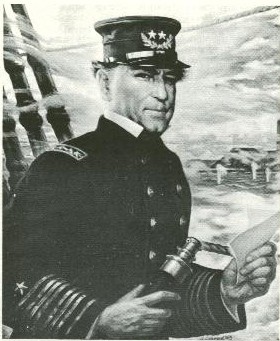
Detailed report of Rear-Admiral Farragut, U.S. Navy, with enclosures.
No. 343.] |
|
|
U.S. FLAGSHIP Hartford, |
Sir: I had the honor to forward to the Department on the evening of the 5th instant a report of my entrée into Mobile Bay on the morning of that day, and which, though brief, contained all the principal facts of the attack.
Notwithstanding the loss of life, particularly on this ship, and the terrible disaster to the Tecumseh, the result of the fight was a glorious victory, and I have reason to feel proud of the officers, seamen, and marines of the squadron under my command, for it has never fallen to the lot of an officer to be thus situated and thus sustained. Regular discipline will bring men to any amount of endurance, but there is a natural fear of hidden dangers, particularly when so awfully destructive of human life as the torpedo, which requires more than discipline to overcome.
Preliminary to a report of the action of the 5th, I desire to call the attention of the Department to the previous steps [taken] in consultation with Generals Canby and Granger. On the 8th of July I had an interview with these officers on board the Hartford on the subject of an attack upon Forts Morgan and Gaines, at which it was agreed that General Canby would send all the troops he could spare to cooperate with the fleet. Circumstances soon obliged General Canby to inform me that he could not dispatch a sufficient number to invest both forts, and in reply I suggested that Gaines should be the first invested, engaging to have a force in the [Mississippi] Sound ready to protect the landing of the army on Dauphin Island, in the rear of that fort, and I assigned Lieutenant-Commander de Krafft, of the Conemaugh, to that duty.
On the 1st instant, General Granger visited me again on the Hartford. In the meantime the Tecumseh had arrived at Pensacola, and Captain Craven had informed me that he would be ready in four days for any service. We therefore fixed upon the 4th of August as the day for landing of the troops and my entrance into the bay, but owing to delays mentioned in Captain Jenkins['] communication to me, the Tecumseh was not ready. General Granger, however, to my mortification, was up to time and the troops actually landed on Dauphin Island.
As subsequent events proved the delay turned to our advantage, as the rebels were busily engaged during the 4th in throwing troops and supplies into Fort Gaines, all of which were captured a few days afterwards.
The Tecumseh arrived on the evening of the 4th, and everything being propitious, I proceeded to the attack on the following morning.
As mentioned in my previous dispatch, the vessels outside the bar, which were designed to participate in the engagement, were all underway by 5:40 in the morning, in the following order, two abreast and lashed together (diagram enclosed, marked "A"):
Brooklyn, Captain James Alden, with the Octorara, Lieutenant-Commander C. H. Greene, on the port side.
Hartford, Captain Percival Drayton, with the Metacomet, Lieutenant-Commander J. E. Jouett.
Richmond, Captain T. A. Jenkins, with the Port Royal, Lieutenant-Commander B. Gherardi.
Lackawana, Captain J. B. Marchand, with the Seminole, Commander E. Donaldson.
Monongahela, Commander J. H. Strong, with the Kennebec, Lieutenant-Commander W. P. McCann.
Ossipee, Commander W. E. Le Roy, with the Itasca, Lieutenant-Commander George Brown.
Oneida, Commander J. R. M. Mullany, with the Galena, Lieutenant-Commander C. H. Wells.
The ironclads Tecumseh, Commander T. A. M. Craven; the Manhattan, Commander J. W. A. Nicholson; the Winnebago, Commander T. H. Stevens; and the Chickasaw, Lieutenant-Commander G. H. Perkins, were already inside the bar, and had been ordered to take up their positions on the starboard side of the wooden ships, or between them and Fort Morgan for the double purpose of keeping down the fire from the water battery and the parapet guns of the fort, as well as to attack the ram Tennessee as soon as the fort was passed.
It was only at the urgent request of the captains and commanding officers that I yielded to the Brooklyn being the leading ship of the line, as she had four chase guns and an ingenious arrangement for picking up torpedoes, and because, in their judgment, the flagship ought not to be too much exposed. This I believe to be an error, for apart from the fact that exposure is one of the penalties of rank in the Navy, it will always be the aim of the enemy to destroy the flagship, and, as will appear in the sequel, such attempt was very persistently made, but Providence did not permit it to be successful.
The attacking fleet steamed steadily up the Main Ship Channel, the Tecumseh firing the first shot at 6:47. At 7:6 [sic] the fort opened upon us and was replied to by a gun from the Brooklyn, and immediately after the action became general.
It was soon apparent that there was some difficulty ahead. The Brooklyn, for some cause which I did not then clearly understand, but which has since been explained by Captain Alden in his report, arrested the advance of the whole fleet, while at the same time the guns of the fort were playing with great effect upon that vessel and the Hartford. A moment after I saw the Tecumseh, struck by a torpedo, disappear almost instantaneously beneath the waves, carrying with her gallant commander and nearly all her crew. I determined at once, as I had originally intended, to take the lead, and after ordering the Metacomet to send a boat to save, if possible, any of the perishing crew, I dashed ahead with the Hartford, and the ships followed on, their officers believing that they were going to a noble death with their commander in chief.
I steamed through between the buoys where the torpedoes were supposed to have been sunk. These buoys had been previously examined by my flag-lieutenant, J. Crittenden Watson, in several nightly reconnoissances. Though he had not been able to discover the sunken torpedoes, yet we had been assured by refugees, deserters, and others of their existence, but believing that from their having been some time in the water, they were probably innocuous, I determined to take the chance of their explosion.
From the moment I turned to the northwestward to clear the Middle Ground we were enabled to keep such a broadside fire upon the batteries at Fort Morgan that their guns did us comparatively little injury.
Just after we passed the fort, which was about ten minutes before 8 o'clock, the ram Tennessee dashed out at this ship, as had been expected, and in anticipation of which I had ordered the monitors on our starboard side. I took no further notice of her than to return her fire.
The rebel gunboats Morgan, Gaines, and Selma were ahead, and the latter particularly annoyed us with a raking fire, which our guns could not return. At two minutes after 8 o'clock I ordered the Metacomet to cast off and go in pursuit of the Selma. Captain Jouett was after her in a moment, and in an hour's time he had her as a prize. She was commanded by P. U. Murphey, formerly of the U.S. Navy. He was wounded in the wrist; his executive officer, Lieutenant Comstock, and 8 of the crew, killed, and 7 or 8 wounded. Lieutenant Commander Jouett's conduct during the whole affair commands my warmest commendations. The Morgan and Gaines succeeded in escaping under the protection of the guns of Type Fort Morgan, which
would have been prevented had the other gunboats been as prompt in their movements as the Metacomet. The want of pilots, however, I believe was the principal difficulty. The Gaines was so injured by our fire that she had to be run ashore, where she was subsequently destroyed, but the Morgan escaped to Mobile during the night, though she was chased and fired upon by our cruisers.
Having passed the forts and dispersed the enemy's gunboats, I had ordered most of the vessels to anchor, when I perceived the ram Tennessee standing up for this ship. This was at 8:45. I was not long in comprehending his intention to be the destruction of the flagship. The monitors and such of the wooden vessels as I thought best adapted for the purpose were immediately ordered to attack the ram, not only with their guns, but bows on at full speed, and then began one of the fiercest naval combats on record.
The Monongahela, Commander Strong, was the first vessel that struck her, and in doing so carried away his own iron prow, together with the cutwater [forward edge of the stem], without apparently doing her adversary much injury. The Lackawanna, Captain Marchand, was the next vessel to strike her, which she did at full speed, but though her stem [forward end of the keel] was cut and crushed to the plank ends for the distance of 3 feet above the water's edge to 5 feet below, the only perceptible effect on the ram was to give her a heavy list.
The Hartford was the third vessel which struck her, but as the Tennessee quickly shifted her helm, the blow was a glancing one, and as she rasped along our side we poured our whole port broadside of IX-inch solid shot within 10 feet of her casemate.
The monitors worked slowly, but delivered their fire as opportunity offered. The Chickasaw succeeded in getting under her stern, and a 15-inch shot from the Manhattan broke through her iron plating and heavy wooden backing, though the missile itself did not enter the vessel.
Immediately after the collision with the flagship I directed Captain Drayton to bear down for the ram again. He was doing so at full speed, when unfortunately the Lackawanna ran into the Hartford, Just forward of the mizzenmast [rear mast in three masted ship], cutting her down to within 2 feet of the water's edge. We soon got clear again, however, and were fast approaching our adversary when she struck her colors and ran up the white flag.
She was at this time sore beset. The Chickasaw was pounding away at her stern, the Ossipee was approaching her at full speed, and the Monongahela, Lackawanna, and this ship were bearing down upon her, determined upon her destruction. Her smokestack had been shot away, her steering chains were gone, compelling a resort to her relieving tackles, and several of her port shutters [shutters covering gun ports] were jammed. Indeed, from the time the Hartford struck her until her surrender she never fired a gun. As the Ossipee, Commander Le Roy, was about to strike her she hoisted the white flag, and that vessel immediately stopped her engine, though not in time to avoid a glancing blow.
During this contest with the rebel gunboats and the ram Tennessee, and which terminated by her surrender at 10 o'clock, we lost many more men than from the fire of the batteries of Fort Morgan.
Admiral Buchanan was wounded in the leg, 2 or 3 of his men were killed, and 5 or 6 wounded. Commander Johnston, formerly of the U.S. Navy, was in command of the Tennessee, and came on board the flagship to surrender his sword and that of Admiral Buchanan.
The surgeon, Dr. Conrad, came with him, stated the condition of the admiral, and wished to know what was to be done with him. Fleet Surgeon Palmer, who was on board the Hartford during the action, commiserating the sufferings of the wounded, suggested that those of both sides be sent to Pensacola, where they could be properly cared for. I therefore addressed a note to Brigadier-General R. L. Page, commanding Fort Morgan, informing him that Admiral Buchanan and others of the Tennessee had been wounded, and desiring to know whether he would permit one of our vessels under a flag of truce to convey them, with or without our own wounded, to Pensacola, on the understanding that the vessel should take out none but the wounded and bring nothing back that she did not take out. This was acceded to by General Page, and the Metacomet proceeded on this mission of humanity.
I enclose herewith the correspondence with that officer (marked 1, 2, 3, and 4). I forward also the reports (marked Nos. 5, 6, 7, 8, 9, 10, 11, 12, 13, 14, 15, 16, 17, 18, 19, 20, and 21) of the commanding officers of the vessels who participated in the action, and who will no doubt call attention to the conduct of such individuals as most distinguished themselves.
As I had an elevated position in the main rigging, near the top, I was able to overlook not only the deck of the Hartford, but the other vessels of the fleet. I witnessed the terrible effects of the enemy's shot and the good conduct of the men at their guns, and although no doubt their hearts sickened, as mine did, when their shipmates were struck down beside them, yet there was not a moment's hesitation to lay their comrades aside and spring again to their deadly work.
Our little consort, the Metacomet, was also under my immediate eye during the whole action up to the moment I ordered her to cast off in pursuit of the Selma. The coolness and promptness of Lieutenant-Commander Jouett throughout merit high praise; his whole conduct was worthy of his reputation.
In this connection I must not omit to call the attention of the Department to the conduct of Acting Ensign Henry C. Nields, of the Metacomet, who had charge of the boat sent from that vessel when the Tecumseh sunk. He took her in under one of the most galling fires I ever saw, and succeeded in rescuing from death ten of her crew within 600 yards from the fort. I would respectfully recommend his advancement.
The commanding officers of all the vessels who took part in the action deserve my warmest commendations, not only for the untiring zeal with which they had prepared their ships for the contest, but for their skill and daring in carrying out my orders during the engagement. With the exception of the momentary arrest of the fleet when the Hartford passed ahead, and to which I have already adverted, the order of battle was preserved, and the ships followed each other in close order past the batteries of Fort Morgan, and in comparative safety, too, with the exception of the Oneida. Her boilers were penetrated by a shot from the fort, which completely disabled her; but her consort, the Galena, firmly fastened to her side, brought her safely through, showing clearly the wisdom of the precaution of carrying the vessels in two abreast. Commander Mullany, who had solicited eagerly to take part in the action, was severely wounded, losing his left arm.
In the encounter with the ram the commanding officers obeyed with alacrity the order to run her down, and without hesitation exposed their ships to destruction to destroy the enemy.
Our ironclads, from their slow speed and bad steering, had some difficulty in getting into and maintaining their position in line as we passed the fort, and in the subsequent encounter with the Tennessee from the same causes, were not as effective as could have been desired, but I can not give too much praise to Lieutenant-Commander Perkins, who, though he had orders from the Department to return North, volunteered to take command of the Chickasaw, and did his duty nobly.
The Winnebago was commanded by Commander T. H. Stevens, who volunteered for that position. His vessel steers very badly, and neither of his turrets will work, which compelled him to turn his vessel every time to get a shot, so that he could not fire very often, but he did the best under the circumstances.
The Manhattan appeared to work well, though she moved slowly. Commander Nicholson delivered his fire deliberately, and, as before stated, with one of his XV-inch shot broke through the armor of the Tennessee with its wooden backing, though the shot itself did not enter the vessel. No other shot broke through her armor, though many of her plates were started and several of her port shutters jammed by the fire from the different ships.
The Hartford, my flagship, was commanded by Captain Percival Drayton, who exhibited throughout that coolness and ability for which he has been long known to his brother officers. But I must speak of that officer in a double capacity. He is the fleet captain of my squadron, and one of more determined energy, untiring devotion to duty, and zeal for the service, tempered by great calmness, I do not think adorns any Navy. I desire to call your attention to this officer, though well aware that in thus speaking of his high qualities I am only communicating officially to the Department that which it knew full well before. To him and to my staff, in their respective positions, I am indebted for the detail of my fleet.
Lieutenant J. Crittenden Watson, my flag-lieutenant, has been brought to your notice in former dispatches. During the action he was on the poop, attending to the signals, and performed his duties, as might be expected, thoroughly. He is a scion worthy the noble stock he sprang from, and I commend him to your attention.
My secretary, Mr. McKinley, and Acting Ensign H. H. Brownell, were also on the poop, the latter taking notes of the action, a duty which he performed with coolness and accuracy.
Two other acting ensigns of my staff, Mr. Bogart and Mr. Heginbotham, were on duty in the powder division, and, as the reports will show, exhibited zeal and ability. The latter, I regret to add, was severely wounded by a raking shot from the Tennessee, when we collided with that vessel, and died a few hours after. Mr. Heginbotham was a young married man, and has left a widow and one child, whom I commend to the kindness of the Department.
Lieutenant A. R. Yates, of the Augusta, acted as an additional aid to me on board the Hartford, and was very efficient in the transmission of orders. I have given him the command temporarily of the captured steamer Selma.
The last of my staff, and to whom I would call the notice of the Department, is not the least in importance. I mean Pilot Martin Freeman. He has been my great reliance in all difficulties in his line of duty. During the action he was in the maintop [elevated platform on main or middle mast], piloting the ships into the bay. He was cool and brave throughout, never losing his self-possession. This man was captured early in the war in a fine fishing smack which he owned, and though he protested that he had no interest in the war and only asked for the privilege of fishing for the fleet, yet his services were too valuable to the captors as a pilot not to be secured. He was appointed a first-class pilot and has served us with zeal and fidelity, and has lost his vessel, which went to pieces on Name Ship Island. I commend him to the Department.
It gives me pleasure to refer to several officers who volunteered to take any situation where they might be useful, some of whom were on their way North, either by orders of the Department or condemned by medical survey. The reports of the different commanders will show how they conducted themselves.
I have already mentioned Lieutenant-Commander Perkins, of the Chickasaw, and Lieutenant Yates, of the Augusta. Acting Volunteer Lieutenant William Hamilton, late commanding officer of the Augusta Dinsmore, had been invalided by medical survey, but he eagerly offered his services on board the ironclad Chickasaw, having had much experience in our monitors. Acting Volunteer Lieutenant P. Giraud, another experienced officer in ironclads, asked to go in on one of these vessels, but as they were all well supplied with officers, I permitted him to go in on the Ossipee under Commander Le Roy. After the action he was given temporary charge of the ram Tennessee.
Before closing this report there is one other officer of my squadron of whom I feel bound to speak, Captain T. A. Jenkins, of the Richmond, who was formerly my chief of staff, not because of his having held that position, but because he never forgets to do his duty to the Government and takes now the same interest in the fleet as when he stood in that relation to me. He is also the commanding officer of the second division of my squadron and as such has shown ability and the most untiring zeal. He carries out the spirit of one of Lord Collingwood's best sayings, "not to be afraid of doing too much; those who are, seldom do as much as they ought." When in Pensacola he spent days on the bar placing the buoys in the best positions, was always looking after the interests of the service, and keeping the vessels from being detained one moment longer in port than was necessary. The gallant Craven told me only the night before the action in which he lost his life, "I regret, admiral, that I have detained you, but had it not been for Captain Jenkins, God knows when I should have been here; when your order came I had not received an ounce of coal."
I feel that I should not be doing my duty did I not call the attention of the Department to an officer who has performed all his various duties with so much zeal and fidelity.
Very respectfully, your obedient servant,
D.G. Farragut,
Rear-Admiral, Commanding West Gulf Blockading Squadron.
I enclose herewith my General Orders, No. 10 and No. 11 (marked 22 and 23), issued before the action, and General Orders, Nos. 12 and 13 (marked 24 and 25), issued after the engagement.
Hon. Gideon Welles,
Secretary of the Navy, Washington.
Enclosure - Diagram A.
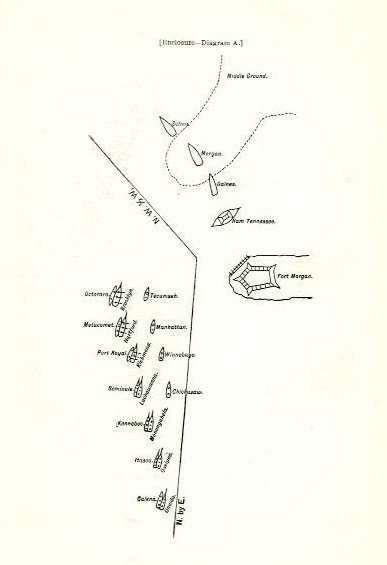
2nd and 3rd Order of Sailing
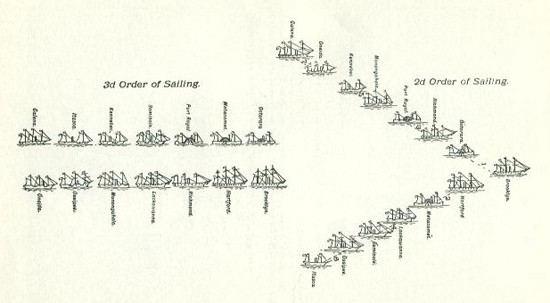
General order of Rear-Admiral Farragut, U.S. Navy.
GENERAL ORDERS, NO. 12. |
|
|
U.S. FLAGSHIP Hartford, |
The admiral returns thanks to the officers and crews of the vessels of the fleet for their gallant conduct during the fight of yesterday.
It has never been his good fortune to see men do their duty with more courage and cheerfulness, for although they knew that the enemy was prepared with all devilish means for our destruction, and though they witnessed the almost instantaneous annihilation of our gallant companions in the Tecumseh by a torpedo, and the slaughter of their friends, messmates, and gunmates on our decks, still there were no evidences of hesitation in following their commander in chief through the line of torpedoes and obstructions, of which we knew nothing except from the exaggerations of the enemy, who had given out that we should all be blown up as certainly as we attempted to enter.
For this noble and implicit confidence in their leader he heartily thanks them.
D. G. Farragut,
Rear-Admiral, Commanding West Gulf Blockading Squadron.
General order of Rear-Admiral Farragut, U.S. Navy.
GENERAL ORDERS, NO. 13. |
|
|
U.S. FLAGSHIP Hartford, |
The admiral desires the fleet to return thanks to Almighty God for the signal victory over the enemy on the morning of the 5th instant.
D. G. Farragut,
Rear-Admiral, Commanding West Gulf Blockading Squadron.
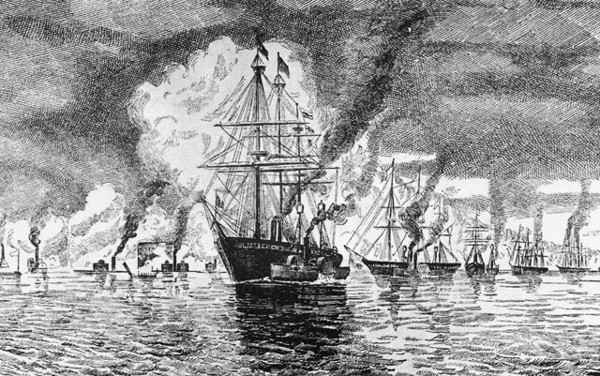
[END]



